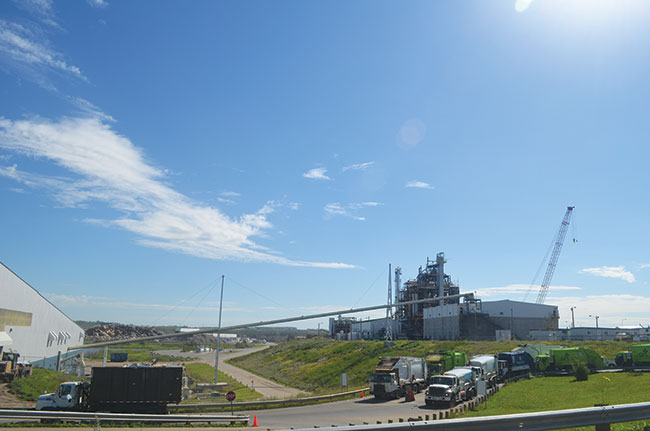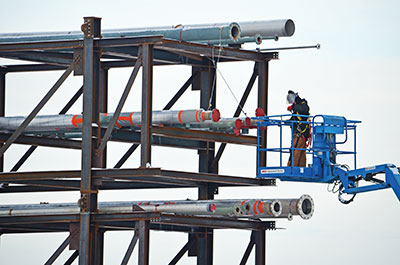
A booming bioeconomy
March 24, 2014
By
Andrew Macklin
Edmonton, Alberta’s provincial capital, is at the heart of Alberta’s resource sector but it has also become the home of the province’s booming bioeconomy.
Edmonton, Alberta’s provincial capital, is at the heart of Alberta’s resource sector but it has also become the home of the province’s booming bioeconomy.

|
|
| The Advanced Energy Research Facility at the City of Edmonton’s waste management facility contains pilot plants for both Enerkem and Forge Hydrocarbons.
|
Alberta sharpened its focus on renewables 10 years ago. Already possessing a strong petrochemical sector, Alberta has strong forestry and agriculture sectors as well. That was where the primary focus of Alberta’s renewable sector began, looking for ways to add value to both agriculture and forestry.
At first, provincial funding was sought after by hundreds of entrepreneurs and researchers, all seeking to approach the same few industrial partners for working agreements. Money was being chased, but industry benchmarks were not being met.
It wasn’t until 2009 that a coordinated effort for research and development was established, thanks in large part to the knowledge and network of Dr. David Bressler of The University of Alberta. Dr. Bressler had originally been hired by the university in 2003 in a cross appointment with Alberta Agriculture. By 2009, his research in the agriculture sector, along with his network throughout Canada’s growing bioeconomy, led him to form the Biorefining Conversions Network.
“It was always about finding value for the agriculture and forestry sectors,” says Dr. Bressler. “That was the focus of the initial investment.”
The investment that came from the Alberta Innovates program was a three-year, $3 million commitment. That money, in turn, was used to leverage close to $8 million in activity with industry partners and university faculties to grow a virtual applied science network for the province. The initial funding helped get the network built and research partnerships in place between industry and academia.
The initial investment in 2009 was successful and led to a re-commitment in 2012, this time with $4 million in funds over a three-year period. The new funding commitment meant funds that weren’t already tied to research projects, allowing the BCN to reach out to industry for feedback on much needed research and development. That includes forestry, where six corporate partners came to the table to help produce a platform of projects that now includes research into tall oil, turpenes ash content, and cellulosic characterization separation. Working with forestry partners has also shrunk the communication gap between industry and academia, helping both parties work to discuss information using the same terminology.
The BCN funding is also helping to bridge the financial gap caused by the economic climate in Alberta. Bioenergy projects in Alberta are based on a successful economic model since there has been no movement to establish a government subsidy for such projects. That makes it difficult to get projects to the commercial stage. But with the BCN funding investing money and resources into development at the bench or pilot plant level, economic models for commercialization can be determined.
There is capital funding available in Alberta for projects that have a strong business case. That funding also falls in line with the successful industries already established in Alberta.
“In Alberta right now, our strengths have traditionally been thermochemical because of the oilsands,” says Dr. Bressler. “We also have a very hydrocarbon-dense economy. Everything we do is based around that infrastructure. Most of the projects we are looking at are going toward high value chemicals.”
In addition to studies looking at turpenes and tall oil, catalysts have become a focus for the BCN. Hundreds of millions had previously been invested in the market because of the petrochemical industry, but now some BCN-funded projects are looking at how some catalysts can be tweaked for use with biomass.
One project that has already emerged from the BCN program is a process that, without using any fat or oil, breaks the molecules to remove the hydrocarbon. A one-litre continuous reactor pilot plant was built at the University of Alberta, and the process was stabilized. Dr. Bressler looked to expand the scale of the technology, but the original industrial partner backed away. The technology caught the eye of Biox founder Tim Haig and, across the last four years, the technology has moved forward with Haig’s support. Two new patent technologies were developed through the program, one on emerging reactive designs and one for getting branching reactions for side chains.
 |
|
| Construction of the $100 million Enerkem waste-to-ethanol plant is scheduled to complete by the end of 2014.
|
The result was the technology being purchased from the University, and Haig is using the system as the foundation for Forge Hydrocarbons. Haig has since been able to work with Dr. Bressler, establishing a 20 litre per hour pilot plant at the Advanced Energy Research Facility at the City of Edmonton’s world class waste management facility. The City of Edmonton is able to provide brown grease and biosolids from municipal waste as a feedstock for the process.
The Forge Hydrocarbon technology on the waste management site is based on removing the glycerol from the grease, oil or biosolid, much like in the creation of biodiesel. But the Forge process also pops off the CO2 molecule and keeps it as a byproduct that can be collected and used for other purposes. The resulting biofuel has a higher hydrocarbon density, lower cost of conversion, and a significant reduction in capital cost. The plant carries just a 10 ft. by 5 ft. by 14ft. footprint, as well as two distillation towers that were constructed by the U of A Faculty of Engineering.
A $100 million commercial waste-to-biofuel plant is on the same site as the Forge Hydrocarbons project. Currently in the final phases of construction, the plant will remove 30 per cent of Edmonton’s landfill waste for the production of cellulosic ethanol.
The commercial biofuel plant is expected to operate day and night, 24/7, in order to work through the amount of commercial and residential waste being generated from the surrounding area. It should produce somewhere in the ballpark of 4500 liters of fuel grade cellulosic ethanol per hour. The overall annual volume of 38 million liters is the per annum target, which represents roughly 14 per cent of the ethanol required by Alberta to meet Canada’s federal mandate of a five per cent ethanol blend. That is the equivalent of the ethanol needed to fuel 400,000 cars a year.
Enerkem also utilizes a five per cent scale pilot plant in the Advanced Energy Research Facility, the same location at the Forge Hydrocarbons pilot plant. The Enerkem plant is used to test a broad range of feedstocks, breaking them down into syngas to be tested for use in other downstream technologies. That includes continued research on the use of CO2 to offset steam use in the ethanol production process.
The development of new bio-solutions for the petrochemical, agriculture and forest industries in Edmonton through the work of the Biorefining Conversions Network, and the addition of the Enerkem facility at the City of Edmonton’s waste management facility, makes this community one of Canada’s emerging bioeconomies.
Print this page